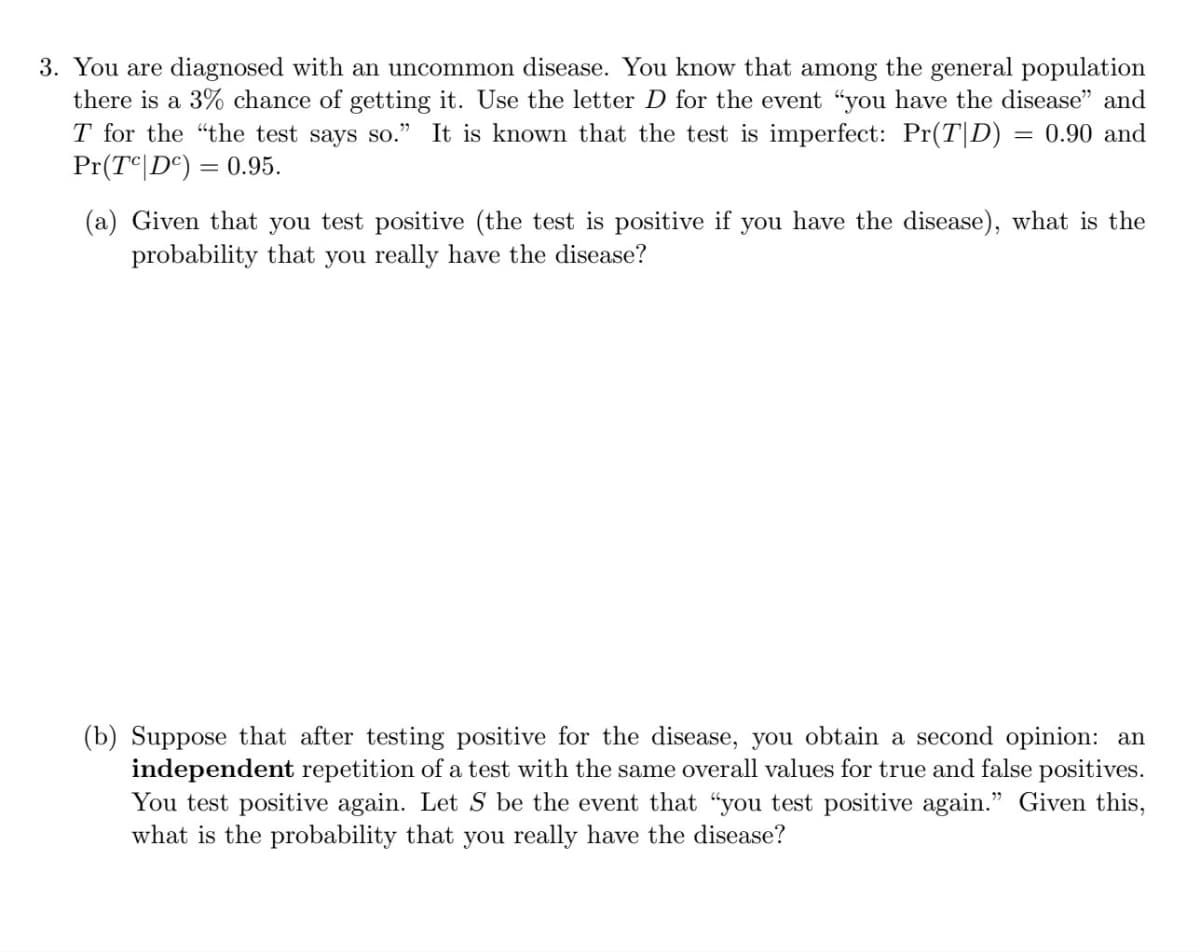3. You are diagnosed with an uncommon disease. You know that among the general population there is a 3% chance of getting it. Use the letter D for the event "you have the disease" and T for the "the test says so." It is known that the test is imperfect: Pr(T|D) = 0.90 and Pr(TC | DC) = 0.95. (a) Given that you test positive (the test is positive if you have the disease), what is the probability that you really have the disease?
3. You are diagnosed with an uncommon disease. You know that among the general population there is a 3% chance of getting it. Use the letter D for the event "you have the disease" and T for the "the test says so." It is known that the test is imperfect: Pr(T|D) = 0.90 and Pr(TC | DC) = 0.95. (a) Given that you test positive (the test is positive if you have the disease), what is the probability that you really have the disease?
Algebra and Trigonometry (MindTap Course List)
4th Edition
ISBN:9781305071742
Author:James Stewart, Lothar Redlin, Saleem Watson
Publisher:James Stewart, Lothar Redlin, Saleem Watson
Chapter14: Counting And Probability
Section14.2: Probability
Problem 3E: The conditional probability of E given that F occurs is P(EF)=___________. So in rolling a die the...
Related questions
Question
P.09

Transcribed Image Text:3. You are diagnosed with an uncommon disease. You know that among the general population
there is a 3% chance of getting it. Use the letter D for the event "you have the disease" and
T for the "the test says so." It is known that the test is imperfect: Pr(T|D) = 0.90 and
Pr(TC | DC) = 0.95.
(a) Given that you test positive (the test is positive if you have the disease), what is the
probability that you really have the disease?
(b) Suppose that after testing positive for the disease, you obtain a second opinion: an
independent repetition of a test with the same overall values for true and false positives.
You test positive again. Let S be the event that "you test positive again." Given this,
what is the probability that you really have the disease?
Expert Solution
This question has been solved!
Explore an expertly crafted, step-by-step solution for a thorough understanding of key concepts.
Step by step
Solved in 4 steps with 14 images

Recommended textbooks for you

Algebra and Trigonometry (MindTap Course List)
Algebra
ISBN:
9781305071742
Author:
James Stewart, Lothar Redlin, Saleem Watson
Publisher:
Cengage Learning

College Algebra (MindTap Course List)
Algebra
ISBN:
9781305652231
Author:
R. David Gustafson, Jeff Hughes
Publisher:
Cengage Learning

College Algebra
Algebra
ISBN:
9781305115545
Author:
James Stewart, Lothar Redlin, Saleem Watson
Publisher:
Cengage Learning

Algebra and Trigonometry (MindTap Course List)
Algebra
ISBN:
9781305071742
Author:
James Stewart, Lothar Redlin, Saleem Watson
Publisher:
Cengage Learning

College Algebra (MindTap Course List)
Algebra
ISBN:
9781305652231
Author:
R. David Gustafson, Jeff Hughes
Publisher:
Cengage Learning

College Algebra
Algebra
ISBN:
9781305115545
Author:
James Stewart, Lothar Redlin, Saleem Watson
Publisher:
Cengage Learning

Holt Mcdougal Larson Pre-algebra: Student Edition…
Algebra
ISBN:
9780547587776
Author:
HOLT MCDOUGAL
Publisher:
HOLT MCDOUGAL